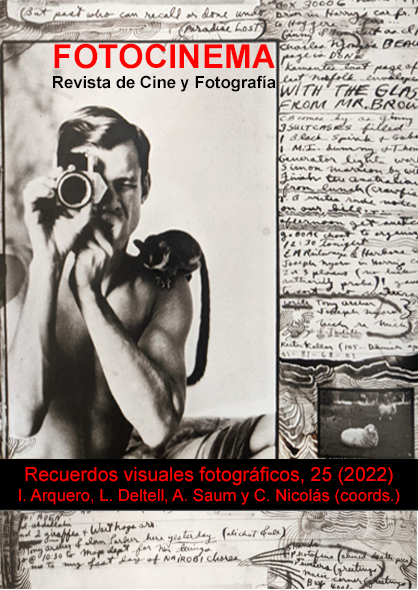The City of Photographers: Space, Image & Memory
DOI:
https://doi.org/10.24310/Fotocinema.2022.vi25.14500Keywords:
Postmemory, Photography, Moreno, Sebastián, Documentary filmsAbstract
In the following work, various ways of approaching the documentary film The City of Photographers by Chilean director Sebastián Moreno, released in 2006, are proposed. Among them are the analysis of the mechanisms used by the memory to store, fix and recreate the traumatic past experienced by Chileans during the military dictatorship of Augusto Pinochet (1973-1990), as well as the textual and narrative analysis of the photographic images that make up the film. To do this, the different types of relationships our memory establishes with space, the archive or art are analyzed based on emotion, the recording of memories and imagination. The work aims to be a contribution to the rescue of Chilean social memory, through the analysis of an autobiographical narrative that starts from the individual to become a multimodal and antithetical collective story, contrary to the official narratives of Pinochetism.
Downloads
Metrics
Publication Facts
Reviewer profiles N/A
Author statements
Indexed in
-
—
- Academic society
- N/A
- Publisher
- Universidad de Málaga
References
Alphen, E. van (2006). Second-Generation Testimony, Transmission of Trauma, and Postmemory. Poetics Today, 27(2), 473-488. https://doi.org/10.1215/03335372-2005-015
Barthes, R. (2009). La cámara lúcida. Notas sobre la fotografía. Paidós.
Basile, T. (2020). De la posmemoria a la doble memoria. Tópicos del Seminario, Semiótica y posmemoria, I(44), 84-111.
Basile, T., y Trigo, A. (2015). Las tramas de la memoria. Introducción. Alter/nativas, 5, 1-11.
Beiner, G. (2008). In Anticipation of a Post Memory Boom Syndrome. Cultural Analysis, 7, 107-112.
Blaine, P. (2013). Representing Absences in the Postdictatorial Documentary Cinema of Patricio Guzmán. Latin American Perspectives, 40(1), 114–130.
Bravi, C. (2021). La ciudad como espacio de construcción de la memoria en el film chileno La ciudad de los fotógrafos. Cine Documental, 5, 1-16.
Camacho, F. & Ramírez L. (2018). Fotografía y memoria visual de la dictadura militar. Reflexiones desde la historia. Revista Austral de Ciencias Sociales, 34, 53-70.
Didi-Huberman, G. (2012). Arde la imagen. Ediciones Ve.
Donoso, A. (2021). La insubordinación de la fotografía. Metales pesados.
Donoso, A. (2022). Re-pensar la memoria fotográfica. Desplazamientos e irrupciones del retrato fotográfico durante la dictadura militar en Chile. En A. López-Labourdette, S. Spitta y V. Wagner (Eds.), Des/memorias. Culturas y prácticas mnemónicas en América Latina y el Caribe (pp. 33-57). Linkgua-digital.
Errázuriz, L. H., y Leiva, G. (2012). El golpe estético. Dictadura militar en Chile (1973-1989). Ocho libros.
Fernández, R., y Hermansen, P. (2009). Aproximaciones metodológicas para una sociología visual a partir del estudio de prácticas de memoria colectiva en el espacio público de la ciudad de Santiago de Chile. Espacio Abierto, 18(3), 445-460.
Freeman, M. (2013). La narración fotográfica. Ensayo y reportaje visual. Blume.
Gamarnik, C. (2012). Fotografía y dictaduras: estrategias comparadas entre Chile, Uruguay y Argentina. Nuevo Mundo Mundos Nuevos. Images, mémoires et sons. https://doi.org/10.4000/nuevomundo.63127
Gorostegui, M. (2019). El documental latinoamericano contemporáneo en el marco de las ciencias sociales: a propósito de La ciudad de los fotógrafos. II Jornadas de sociología UNMdP. Universidad Nacional del Mar del Plata, 1-19.
Halbwachs, M. (1990). Espacio y memoria colectiva. Estudios sobre las Culturas Contemporáneas, III(9), 11-40.
Hirsch, M. (1997). Family Frames: Photography, Narrative, and Postmemory. Harvard University Press.
Hirsch, M. (2019). Connective Arts of Postmemory. Analecta Política, 9(16), 171-176.
Martin-Jones, D. (2013). Archival Landscapes and Non-Anthropocentric Universe Memory. Third Text, 27(6), 707-722. https://doi.org/10.1080/09528822.2013.857901
Memoria chilena. (s.f.). La Asociación de Fotógrafos Independientes (AFI) (1981-1990). http://www.memoriachilena.gob.cl/602/w3-article-3499.html
Monteiro, C. (2018). Imagens do Chile: a fotografia documental entre a denúncia social e a expressão autoral. Estudos Ibero-Americanos, 44(3), 528-535. https://doi.org/10.15448/1980-864X.2018.3.31742
O’Keane, V. (2021). El bazar de la memoria. Siruela.
Quílez, L. (2014). Hacia una teoría de la posmemoria. Reflexiones en torno a las representaciones de la memoria generacional. Historiografías, 8, 57-75.
Richard, N. (2011). Lo político y lo crítico en el arte. Institut Valencià d’Art Modern (IVAM).
Richard, N. (2007). Fracturas de la memoria. Arte y pensamiento crítico. Siglo XXI.
Rouillé, A. (2017). La fotografía. Entre documento y arte contemporáneo. Herder.
Tavares da Silva, D. (2015). Então entra, porque continuo te vendo: ambiguidade e melancolia em La ciudad de los fotógrafos. Significação, 42(44), 142-159.
Trigo, A. (2015). Memorias digitales (o la digitalización de la memoria). Alter/nativas, 5, 1-39.
Zambrano, M. (1995). La confesión: género literario. Siruela.
Downloads
Published
How to Cite
Issue
Section
License
All contents published in Fotocinema Revista científica de cine y fotografía are protected under the Creative Commons Attribution-NonCommercial-ShareAlike 4.0 International (CC BY-NC-SA 4.0) license. All about this license is available in the following link: <http://creativecommons.org/licenses/by-nc-sa/4.0>
Users can copy, use, redistribute, share and exhibit publicly as long as:
- The original source and authorship of the material are cited (Journal, Publisher and URL of the work).
- It is not used for comercial purposes.
- The existence of the license and its especifications are mentioned.
There are two sets of authors’ rights: moral and property rights. Moral rights are perpetual prerogatives, unrenounceable, not-transferable, unalienable, imprescriptible and inembargable. According to authors’ rights legislation, Fotocinema. Revista científica de cine y fotografía recognizes and respects authors moral rights, as well as the ownership of property rights, which will be transferred to University of Malaga in open access. The property rights are referred to the benefits that are gained by the use or the dissemination of works. Fotocinema. Revista científica de cine y fotografía is published in an open access form and it is exclusively licenced by any means for doing or authorising distribution, dissemination, reproduction, , adaptation, translation or arrangement of works.
Authors are responsable for obtaining the necessary permission to use copyrighted images.














13.png)



